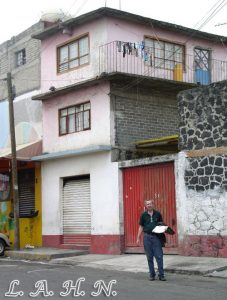In the first two years that we were creating the Latin American Housing Network we decided to begin data collection in a range of irregular settlements in three cities (Mexico City, Bogotá, and Guatemala where two of us (Peter Ward and Bryan Roberts) had conducted household surveys in the late 1960s and early/mid 1970s. The idea was to try to return to the exact same dwellings and lots in which we had interviewed owners some thirty years ago when these colonias were incipient or just beginning to consolidate physically. Locating these exact same dwellings was no easy task of course; new streets had been created, street names had changed; and lot numbers had changed often several times over. But when we were confident that we had, indeed, located the same lot were interested in testing a number of hypotheses: 1) That a large proportion of the lots were still occupied by the same families (usually the [now] adult children); 2) that densities were high and multiple lot sharing existed –usually between adult children; 3) that adult children were inheriting the patrimony; and 4) that the now fully consolidated housing had a relatively high (exchange) value.

Dr. Peter Ward interviewing in Isidro Fabela in 2007, standing in front of the house in which he rented a room in 1973.
Therefore in July and August 2007 we conducted restudy of some 350 low-income owner self builder households across eight settlements in Bogotá and Mexico City that were first interviewed in the 1970s as part of a major housing study (see Gilbert and Ward, 1985 and recently [2009] reissued by Cambridge University Press in paperback [See “Network Publications]). The aim was: to ascertain the level of turnover in the families during a thirty year period, current housing arrangements of households in dwellings and lots, papers and expectancies of ownership and inheritance among (now) adult children and grandchildren. The findings show that there has been minimal land use change and more than 80 percent of the original families were still occupying the lot, (even though the original owner may have died). Lot densities have increased significantly, as has the average number of households per lot. In Mexico sharing a lot is almost exclusively close kin (adult children); while in Bogotá they are kin as well as renter households. Self estimates and tax office assessments show that the value of lots is considerable, with median values approaching $90,000 and $25,000 in Mexico City and Bogotá respectively. Residential mobility is highly constrained, therefore, partly because of the use value of second and third generation households who now live on the lots and have little incentive (or option) to leave). Also, given the lack of formal financing support, the significant property values make it virtually impossible to sell out and move elsewhere. The social, judicial (tenure and inheritance), and housing policy implications are discussed.
The protocols and findings for the Bogotá and Mexico City studies are available for review in the following sections of this page and include the datasets (blinded) in EXCEL and SPSS format. These datasets may also be accessed through the “Research Findings and Databases” Portal. Fieldwork for this study was conducted by: Peter Ward, Maria García and Lisette Aliaga Linares (Bogotá); and by Peter Ward, Edith Jiménez, Cristina Saborio, Alejandra Ramírez Cuesta & Erika Grajeda (Mexico City).
Publications arising from this 2007 survey are available in the “Network Publications” of this website. (Note: a shorter published version in Spanish is open access. The longer version in English is under review for publication and is therefore password protected and is available only to project participants.)
For details about the Guatemala study, please see the Guatemala 2008 Restudy.
Files available for download:

